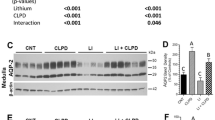Abstract
Homeostasis of inorganic sulfate is maintained by the capacity-limited renal reabsorption of sulfate in the proximal tubule. The purpose of the present investigation was to determine if probenecid, the classical inhibitor of renal organic anion secretion, may affect sulfate renal clearance. Two groups of rats were administered in a randomized crossover design, an i.v. bolus dose (20.6 or 92.4 mg/kg) and 4-hr infusion (0.28 or 0.59 mg/min/kg) of probenecid or vehicle, and blood and urine samples were collected. At a steady-state serum concentration of 0.45 mM, probenecid had no significant effect on the serum concentrations or renal clearance of inorganic sulfate, whereas at a serum concentration of 1.4 mM, probenecid treatment caused a significant decrease in serum sulfate concentrations (0.57 ± 0.11 vs 0.96 ± 0.19 mM in controls, mean ± SD, n = 6, P < 0.001) due to an increase in the renal clearance of sulfate (3.88 ± 1.18 vs 2.13 ± 0.84 ml/min/kg in controls, P < 0.01). The fraction of the filtered sulfate that was reabsorbed was significantly decreased (0.38 ± 0.23, vs 0.74 ± 0.09 in controls, P < 0.01). Therefore, probenecid treatment results in the inhibition of the renal reabsorption of inorganic sulfate in rats in vivo.
Similar content being viewed by others
REFERENCES
G. J. Mulder. Sulfation in vivo and in isolated cell preparations. In G. J. Mulder (ed.), Sulfation of Drugs and Related Compounds, CRC Press, Boca Raton, FL, 1981, pp. 131–186.
E. L. Becker, H. O. Heinemann, K. Igaraski, J. E. Hodler, and H. Gershberg. Renal mechanisms for the excretion of inorganic sulfate in man. J. Clin. Invest. 39:1909–1913 (1960).
F. Berglund. Transport of inorganic sulfate by the renal tubules. Acta Physiol. Scand. 49 (Suppl. 172):1–37 (1981).
J. H. Lin and G. Levy. Renal clearance of inorganic sulfate in rats: Effect of acetaminophen-induced depletion of endogenous sulfate. J. Pharm. Sci. 72:213–217 (1983).
K. Hierholzer, R. Cade, R. Gurd, R. Kessler, and R. Pitts. Stop flow analysis of renal reabsorption and excretion of sulfate in the dog. Am. J. Physiol. 198:833–837 (1960).
H. Lücke, G. Stange, and H. Murer. Sulphate-ion/sodium-ion co-transport by brush border membrane vesicles isolated from rat kidney cortex. Biochem. J. 182:223–229 (1979).
K. J. Ullrich, G. Rumich, and S. Klöss. Bidirectional active transport of thiosulfate in the proximal convolution of the rat kidney. Pflügers Arch. 387:127–132 (1980).
J. B. Pritchard and J. L. Renfro. Renal sulfate transport at the basolateral membrane is mediated by anion exchange. Proc. Natl. Acad. Sci. USA 80:2603–2607 (1983).
I. Löw, T. Friedrich, and G. Burckhardt. Properties of an anion exchanger in rat renal basolateral membrane vesicles. Am. J. Physiol. 246:F334–F342 (1984).
J. V. Møller and M. I. Sheikh. Renal organic anion transport system: Pharmacological, physiological and biochemical aspects. Pharmacol. Rev. 34:315–358 (1983).
K. J. Ullrich, G. Rumrich, and S. Klöss. Contraluminal organic anion and cation transport in the proximal renal tubule. V. Interaction with sulfamoyl and phenoxy diuretics with β-lactam antibiotics. Kidney Int. 36:78–88 (1989).
I. J. Deyrup. Effect on kidney S35O4 uptake of compounds related to SO4 transport and metabolism. Am. J. Physiol. 207:84–88 (1964).
F. Berglund. Comparison between effects of carinamide and probenecid on thiosulphate secretion in the renal tubules of the dog. Acta Pharmacol. Toxicol. 19:371–376 (1962).
A. Selen, G. L. Amidon, and P. G. Welling. Pharmacokinetics of probenecid following oral doses to human volunteers. J. Pharm. Sci. 71:1238–1242 (1982).
B.-M. Emanuelsson, B. Beerman, and L. K. Paalzow. Nonlinear elimination and protein binding of probenecid. Eur. J. Clin. Pharmacol. 32:395–401 (1987).
B.-M. Emanuelsson and L. K. Paalzow. Dose-dependent pharmacokinetics of probenecid in the rat. Biopharm. Drug Disp. 9:59–70 (1988).
R. K. Harle and T. Cowen. Determination of probenecid in serum by high performance liquid chromatography. Analyst 103:492–496 (1978).
M. E. Morris and G. Levy. Assay of inorganic sulfate in biologic fluids by nonsuppressed (single-column) ion chromatography. Anal. Biochem. 172:16–21 (1988).
H. Cheng and W. J. Jusko. Mean residence time concepts for pharmacokinetic systems with nonlinear drug elimination described by the Michaelis-Menten equation. Pharm. Res. 5:156–164 (1988).
M. E. Morris and G. Levy. Serum concentration and renal excretion by normal adults of inorganic sulfate after acetaminophen, ascorbic acid, or sodium sulfate. Clin. Pharmacol. Ther. 33:529–536 (1983).
K. J. Ullrich, G. Rumrich, and S. Klöss. Contraluminal sulfate transport in the proximal tubule of the rat kidney. II. Specificity: Sulfate ester, sulfonates and aminosulfonates. Pflügers Arch. 404:293–299 (1985).
K. J. Ullrich, G. Rumrich, and S. Klöss. Contraluminal sulfate transport in the proximal tubule of the rat kidney. IV. Specificity: salicylate analogs. Pflügers Arch. 404:307–310 (1985).
M. E. Morris, O. Kwon, and I. L. Mansfield. Sulfate homeostasis. I. Effect of salicylic acid and its metabolites on inorganic sulfate in rats. J. Pharmacol. Exp. Ther. 244:945–949 (1988).
B. J. de Vries, W. B. van den Berg, and L. B. A. van de Putte. Salicylate-induced depletion of endogenous inorganic sulfate. Potential role in the suppression of sulfated glycosaminoglycan synthesis in murine articular cartilage. Arth. Rheum. 28:922–929 (1985).
B. J. de Vries, P. M. van der Kraan, and W. B. van den Berg. Effects of drug mediated serum sulfate depletion on glycosaminoglycan synthesis. Agents Actions 29:224–231 (1990).
D. E. Humpries, C. K. Silbert, and J. E. Silbert. Glycosaminoglycan production by bovine aortic endothelial cells cultured in sulfate-depleted medium. J. Biol. Chem. 261:9122–9127 (1986).
R. E. Galinsky and G. Levy. Dose-and time-dependent elimination of acetaminophen in rats: Pharmacokinetic implications of cosubstrate depletion. J. Pharmacol. Exp. Ther. 219:14–20 (1981).
R. H. Demeio. Sulfate activation and transfer. In D. M. Greenway (ed.), Metabolic Pathways, 3rd ed., Academic Press, New York, 1975, pp. 287–357.
W. B. Huttner and P. A. Bauerle. Protein sulfation on tyrosine. Mod. Cell Biol. 6:97–140 (1988).
Author information
Authors and Affiliations
Rights and permissions
About this article
Cite this article
Darling, I.M., Morris, M.E. Sulfate Homeostasis. IV. Probenecid-Induced Alterations of Inorganic Sulfate in Rats. Pharm Res 8, 376–379 (1991). https://doi.org/10.1023/A:1015805918168
Issue Date:
DOI: https://doi.org/10.1023/A:1015805918168




